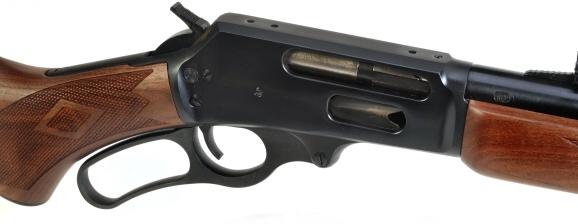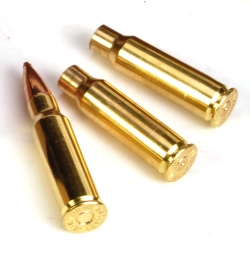
The Marlin Model 338MX is an exceptionally well-thought-out combination for big game hunting applications. Marlin managed to retain the benefits of a compact traditional lever gun while providing substantial power and reach. The core of this performance is the 338 Marlin Express. The 338 Marlin Express cartridge, like the 308 Marlin Express cartridge, is based upon the 376 Steyr, shortened to a 1.890″ case length and 2.585″ overall length to facilitate cycling through the Marlin 336 action.
Most owners will purchase competitively priced Hornady 338 Marlin Express 200 grain LeverEvolution factory ammunition and use the gun for hunting everything from whitetail deer to moose and bear. However, the 338 Marlin Express also represents an opportunity for handloaders to open the combination to additional hunting applications and to tailor it to individual preferences.
Bullet, bullet, who’s got the bullet…

Selecting factory ammunition for the 338 Marlin Express is relatively straight forward as there is only one factory load. Hornady’s LeverEvolution 200 grain FlexTip is rated at 2,565 fps and 2,922 ft/lbs in concert with a 24″ barrel. The same ammo clocked 2,515 fps over our chronograph with the 22″ barrel Marlin Model 338MX.
 The 200 grain flexible tip bullet used in the Hornady tubular magazine safe factory ammo is also sold as a component through retail suppliers. The same is true of Hornady’s LeverEvolution smokeless powder. Hodgdon’s reloading data puts the top 200 grain 338 Marlin Express load at 47.5 grains 2,493 fps and 46,000 psi. Hornady 8th Edition tops out at 47.1 grains 2,400 fps with no pressure indicated. SAAMI MAP for this cartridge is 46,000 psi. Spill over full case capacity is 61.0 grains of water.
The 200 grain flexible tip bullet used in the Hornady tubular magazine safe factory ammo is also sold as a component through retail suppliers. The same is true of Hornady’s LeverEvolution smokeless powder. Hodgdon’s reloading data puts the top 200 grain 338 Marlin Express load at 47.5 grains 2,493 fps and 46,000 psi. Hornady 8th Edition tops out at 47.1 grains 2,400 fps with no pressure indicated. SAAMI MAP for this cartridge is 46,000 psi. Spill over full case capacity is 61.0 grains of water.
In preparation for reloading, I disassembled a few factory rounds and found 50.8 grains of powder in each, however, I could not positively identify the powder type, so I couldn’t attribute weight of the factory charge as the source of the published higher factory ammo muzzle velocity. Hornady 8th Edition offers a variety of powder choices within their 338 Marlin Express data.
 The ballistic difference between a 200 grain Hornady LeverEvolution bullet and a traditional flat nose bullet, both launched at 2,500 fps is a 2.9″ difference in drop at 300 yards zero; 9.3″ and 11.9″ respectively. This is not much of a compromise in performance, however, changes to retained velocity and associated indicators follow. The Hornady LeverEvolution FlexTip slug at 300 yards is moving along at 1,937 fps with 1666 ft/lbs of energy while a flat nose, meeting greater air resistance, slows to a velocity of 1,1691 fps with 1,270 ft/lbs of energy. This gives credence to Hornady’s flex tip spitzer approach.
The ballistic difference between a 200 grain Hornady LeverEvolution bullet and a traditional flat nose bullet, both launched at 2,500 fps is a 2.9″ difference in drop at 300 yards zero; 9.3″ and 11.9″ respectively. This is not much of a compromise in performance, however, changes to retained velocity and associated indicators follow. The Hornady LeverEvolution FlexTip slug at 300 yards is moving along at 1,937 fps with 1666 ft/lbs of energy while a flat nose, meeting greater air resistance, slows to a velocity of 1,1691 fps with 1,270 ft/lbs of energy. This gives credence to Hornady’s flex tip spitzer approach.
In the photo to the right are the Hornady 200 grain FlexTip and a 180 grain version of a flat nose bullet produced by Hawk Bullets. Hawk makes an excellent product with a soft lead core and a pure copper jacket. I’ve loaded them for everything up to the 500 Jeffery with excellent results; big controlled expansion, deep penetration and good external ballistics. Still, there is only so much that can be done with a flat nose bullet and its use with the 338 Marlin Express will require some accommodations. Where factory ammo provides the high levels of external ballistic performance, handloading the same Hornady bullet as a component would significantly lower ammunition cost and handloading with flat nose jacketed or cast bullet would provide lower cost and perhaps greater round flexibility at a modest loss of reach.
And what does that look like?
I did not include cast bullet load data. I normally use cast bullets where jacketed bullets are not available, or where muzzle velocity is south of 2,000 fps; arbitrary and not technical restrictions. The 338 Marlin Express is as viable with cast bullets as the 45-70 Gov’t and this model Marlin has conventional rifling which works well with cast products. Reloading data for the 338 Marlin Express is published in the RealGuns handload section.

There are a number of cast bullets available from weights as low as 205 grains and as heavy as 250 grains that are cast for the .338 Winchester Magnum and not the .33 WCF, but I can’t see the benefit. These cast bullets also have a flat nose, they aren’t much less in cost than jacketed bullets and they are typically not stocked so waiting will be required. Hawk bullets offer both 200 grain and 250 grain bullets in addition to the 180 grain, so practical bullet weights for this cartridge are covered.
To put performance in perspective, the ballistics on the table above for 180 grain bullets reflect better performance than the 308 Winchester. Marlin lists the 338 Marlin Express as enough gun for any North American game. It is a pretty hard hitting cartridge – gun combination.
The Marlin Model 338MX
 The 338 Marlin Express is near the maximum progression in performance that can be accomplished with a lever gun of traditional design. The combined Marlin – Hornady project stayed well within the firearms pressure limits, magazine type and practical barrel length… while delivering a 300 yard gun with big game level terminal ballistics. Blued steel and walnut, there are no plastic parts to be found, it’s sub $550 price tag at retailers makes the gun an incredible value.
The 338 Marlin Express is near the maximum progression in performance that can be accomplished with a lever gun of traditional design. The combined Marlin – Hornady project stayed well within the firearms pressure limits, magazine type and practical barrel length… while delivering a 300 yard gun with big game level terminal ballistics. Blued steel and walnut, there are no plastic parts to be found, it’s sub $550 price tag at retailers makes the gun an incredible value.
Accuracy is very good. The Marlin could shoot 1¼” and better all day long without particular concern for ammunition type. Careful handloads with the Hornady bullet shrunk to as little as 0.7″ a number of times. Recoil is modest, as is muzzle blast, and the metallic sights are very useful out to about 100 yards. A receiver mounted scope would extract much more of the gun’s potential. Good gun, well-made and lots of power.

Email Notification